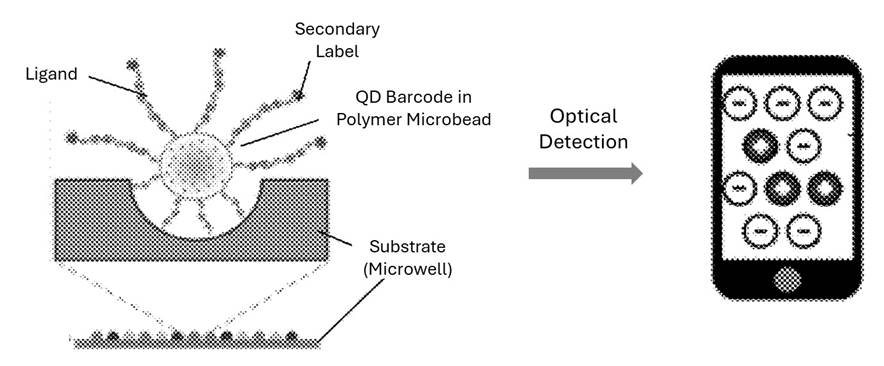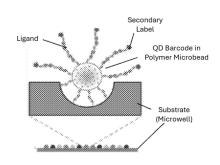BACKGROUND
Rapid, multiplexed detection of biological and chemical targets is critical in fields such as medical diagnostics, food safety, and environmental monitoring. Traditional detection systems often require bulky, expensive laboratory equipment and trained personnel, limiting their use in point-of-care or field settings. While barcode-based detection systems offer a promising route to multiplexing, they typically rely on specialized readers or optical setups. With the widespread availability of smartphones and other wireless communication devices equipped with high-resolution cameras and computational capabilities, there is a growing opportunity to develop portable, low-cost detection systems that leverage these ubiquitous technologies.
TECHNOLOGY
Researchers at the University of Toronto have developed a wireless, chip-based detection system that integrates quantum dot (QD) barcode technology with portable wireless communication devices such as smartphones. The system uses a primary label containing the QD barcode conjugated to a ligand, and a secondary label for determining successful capture of the target (Figure 1). An optical signature comprising the primary label/barcode signal and the secondary label signal indicates positive detection of the target of interest from a sample. The optical signal can be imaged and analyzed using a mobile device that can also transmits the data wirelessly to a remote server or application for real-time analysis. This platform enables simultaneous detection of multiple analytes in a single test, with results available within minutes.

Figure 1. Quantum dot barcode-based multiplex detection using mobile devices. A primary label containing the QD barcode is coated on to the surface a microwell. Binding of a target to the primary label ligand, facilitates the attachment of a ligand attached to a secondary label that confirms target presence. The combined signal from the primary and secondary ligands can be read by a mobile device or other optical detection system.
COMPETITIVE ADVANTAGE
- Portability: Eliminates the need for bulky lab equipment by using smartphones or tablets for detection.
- Low Cost: Utilizes inexpensive substrates and consumer-grade devices, reducing overall system cost.
- Rapid Multiplexing: Detects multiple targets simultaneously in a matter of minutes.
- Wireless Integration: Enables real-time data transmission and remote analysis.
- Broad Applicability: Suitable for use in healthcare, agriculture, food safety, and environmental monitoring.
APPLICATIONS
- Point-of-care diagnostics
- Pathogen detection in food and water
- Agricultural disease monitoring
- Environmental contaminant screening
- Mobile health and telemedicine platforms
INTELLECTUAL PROPERTY STATUS
- Granted CA and US patents (US10345240B2)
PROJECT STATUS
Proof-of-concept studies have been conducted demonstrating multiplexed detection of several viruses.
KEYWORDS
wireless detection, barcode, smartphone diagnostics, multiplex assay, mobile health, point-of-care, pathogen detection, chip-based sensor, portable biosensor





